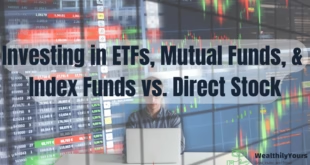One of the most promising strategies is investing for monthly income, which involves putting money into assets that pay out regular earnings. In an uncertain economic climate, many people in the UK are seeking ways to generate a steady income stream without relying entirely on a traditional job.
Whether you’re aiming for financial independence, supplementing your pension, or covering essential expenses, this approach can offer stability and predictability.
This article explores how investing for monthly income can be effectively pursued through dividend investing, particularly with income-generating ETFs (Exchange Traded Funds), and how you might aim for a target monthly income of £2000.
Also Read: https://wealthilyyours.com/5-powerful-lessons-from-the-intelligent-investor/
Understanding Investing for Monthly Income
At its core, investing for monthly income means focusing your investment strategy on assets that deliver cash flow on a regular basis. These can include dividend-paying stocks, bonds, real estate, and most efficiently, ETFs that focus on income distribution. The idea is to build a portfolio that generates consistent returns, allowing you to receive income without selling off assets.
In the UK, investors can benefit from tax-advantaged accounts like ISAs (Individual Savings Accounts), which allow tax-free income from investments up to certain limits. Leveraging these vehicles is an essential part of a tax-efficient income strategy.
Why Dividend Investing Through ETFs?
Dividend investing involves buying shares in companies that distribute a portion of their earnings as dividends. While you can buy individual dividend stocks, ETFs offer a more diversified and lower-risk approach. ETFs that are focused on high dividend yield or monthly distribution simplify investing for monthly income by pooling multiple income-generating stocks into one vehicle.
Here are some examples of income-focused ETFs available to UK investors:
- iShares UK Dividend UCITS ETF (IUKD) – Targets high-dividend-paying UK companies.
- Vanguard FTSE UK Equity Income Index Fund – Tracks FTSE UK Equity Income Index.
- SPDR S&P Global Dividend Aristocrats UCITS ETF – Invests in global dividend aristocrats.
- Invesco Monthly Income Plus Fund – Includes both bonds and equities for monthly payouts.
These ETFs typically distribute income on a monthly or quarterly basis, making them ideal for those focused on investing for monthly income.
Also Read: https://wealthilyyours.com/how-to-retire-early-in-the-uk/
Example: Earning £2000/Month Through ETF Dividend Investing
To generate a monthly income of £2000, or £24,000 annually, let’s consider a realistic yield expectation. High-quality dividend ETFs in the UK often yield between 3% and 5% annually.
Let’s assume an average dividend yield of 4%. To calculate the total investment needed:
£24,000 / 0.04 = £600,000So, a portfolio worth £600,000 invested in dividend ETFs with an average yield of 4% could potentially provide a monthly income of around £2000.
Here’s how you could build that portfolio:
- 40% in Vanguard FTSE UK Equity Income Index Fund (Quarterly dividends)
- 30% in iShares UK Dividend UCITS ETF (IUKD) (Monthly or quarterly pay outs)
- 20% in SPDR S&P Global Dividend Aristocrats ETF (Quarterly)
- 10% in Invesco Monthly Income Plus Fund (Monthly income)
Also Read: https://wealthilyyours.com/why-are-index-funds-lucrative-top-5-index-fund-etfs-in-the-uk/
This kind of distribution not only supports investing for monthly income but also provides a good balance between UK-focused and global dividend-paying assets.
Reinvesting and Growth
In the early stages, you might not start with £600,000, and that’s okay. The power of compounding means that by reinvesting dividends, your portfolio grows faster. Many ETFs offer automatic reinvestment plans (DRIPs) that can be activated until your income target is achieved. This phased strategy still aligns with the principle of investing for monthly income, just on a delayed pay out timeline.
Risk Considerations
Like all investment strategies, investing for monthly income comes with risks. Dividends are not guaranteed and can be cut if a company’s earnings fall. Market fluctuations can also impact the capital value of your ETF holdings. Diversification, as discussed, is key. Additionally, income-focused investors should monitor expense ratios, liquidity, and the underlying asset quality of ETFs.
Tax Implications in the UK
For UK residents, using a Stocks and Shares ISA is one of the most efficient ways to implement investing for monthly income, as any dividends received within the ISA are tax-free. Outside of an ISA, you have a dividend allowance (£500 for 2024/25), and income above this is taxed based on your income tax band.
Also Read: https://wealthilyyours.com/cash-isa-vs-stocks-and-shares-isa-9-pointer-comparison-for-uk-investors/
Planning your withdrawals and contributions with tax efficiency in mind is crucial when you’re investing for monthly income to avoid eroding returns.
Final Thoughts
Investing for monthly income is not only achievable but also sustainable when done thoughtfully. ETFs provide an accessible, diversified, and relatively low-cost method for UK investors to generate passive income. Whether you’re aiming to supplement your salary, prepare for retirement, or achieve financial independence, a structured dividend strategy with income-focused ETFs can be a powerful part of your portfolio.
Always remember to review your strategy regularly, stay informed on ETF performance, and consider speaking with a financial advisor to tailor your investments to your unique goals. With patience and planning, investing for monthly income can turn your capital into a reliable income engine.
Disclaimer
This article is intended for informational purposes only and does not constitute financial, tax, or investment advice. Always do your own research or consult with a certified financial advisor before making any investment decisions. Past performance is not indicative of future results, and all investments carry risk.
Enjoyed the Post? Share Your Thoughts and Spread the Word!
If you found this blog post informative and helpful, I’d love it if you could share it with your friends, family, or anyone who might benefit from it. Your support helps me reach more readers and continue creating content like this!
Also, I’d love to hear from you! What are your thoughts on the topic? Do you have any questions or insights to add? Drop a comment below - I’m here to chat and learn from your perspective too.
Thank you for being part of this journey, and I can’t wait to hear what you think!
 WealthilyYours Empowering You to Grow, Invest, and Thrive
WealthilyYours Empowering You to Grow, Invest, and Thrive





I appreciate you sharing this blog post. Thanks Again. Cool.